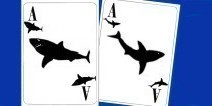|

Join our Newsletter
& get our free guide Starting Hands Revealed
We hate spam too!
We value your privacy and never share your email. All our emails have an opt-out link. Click it, and you will never hear from us again. |
Hold'em Poker Statistical Jargon explainedYou do not need a Ph.D. in math or statistics for understanding the concepts of odds in poker. Overall simple math explains it all. But there are a number of specific terms that you need to know in order to be able to play poker optimally. What are poker statistics?If you want to bring your online poker game to the next level, it is important to understand and to follow a number of poker statistics. A statistic is just a measure of some function depending on the data, for example an average is a statistic or a standard deviation likewise. There are all kinds of detailed statistics provided by poker tracking software vendors such as poker-edge. In the section below, we review a few of the most useful poker statistics. xx/yy/zzIn any hand review analysis or poker strategy discussion, you will often see a player described as 18/13/3 or 65/30/1. As we alluded in Players' Styles, the three statistics in question are VPIP/PFR/AF, used as a group. Focus on just understanding these three simple numbers first. They summarize any player's style of play very accurately. Other statistics are just a refinement over this initial summary. VPIP is the percentage of hands (voluntarily) played, voluntarily meaning that in an unraised pot the big blind will play but he did not have to make a decision to do so, so such hands are not included. VPIP shows where a player stands on the loose-tight scale, and the range of VPIP seen in low to mid stakes online poker games is between 8 and 70. There are even players with VPIP around 3 or 90. These unbelievably tight or loose players are seen once in a while. Forget about the tight ones (just get off the way when they start betting). On the other hand, the loose players with VPIP over 70 are calling stations, who will make you a lot of money. In a full ring texas hold'em game, optimal VPIP is around 13-20, whereas in 6 max games it is about 16-30. Values outside these ranges are excessive and imply predictability, which can be exploited by observant players. PFR stands for preflop raise, i.e. the percent of hands a player raises preflop. This is a representation of his aggression, as timid players will only raise their monsters such as {QQ+,AKs}, while maniacs may raise any hand somehow remote from pure garbage. AF stands for aggression factor (the main AF measure is total postflop AF, i.e. excluding preflop actions). It is the ratio (#bets + #raises)/#calls, so the more you take the initiative by betting or raising instead of just calling, the higher your AF. PFR and AF as a pair represent aggression, pre and postflop. Some fish only raise postflop, conversely some semi-fish are very aggressive preflop but do not follow up postflop, so the pair PFR/AF reflects these distinctions. 
Continuation bets and donk betsAlso called in short cbet or c-bet, the continuation bet is a bet made by the player who had the initiative at the previous street. For example when a player raises preflop and get called, if he is the first to bet at the flop, this is called a continuation bet. Continuation bet almost always refers to betting at the flop, but it could also apply to later streets. Raising preflop is a demonstration of strength, so the player who raised must continue to bet to show that he is still leading, otherwise it is a clear sign of weakness. Henceforth a cbet is normally expected from the preflop raiser. What happened sometimes if the preflop raiser is not the first to act is that another player raises before him instead. This is called a donk bet because no one should raise in place of the preflop raiser, who is expected to do so. Doing a donk bet is taking the risk that the initial raiser folds if he missed the flop, and this is usually done by novice players. Note that both cbet and donk bet percentages are statistics, i.e. the percentage that a player makes these actions, and they are tracked by poker tracking software such as poker-edge. Pot equity
Pot equity is the percent chance of winning the pot at a given point during a hand. In other words, this is how much percent of the pot a player owns statistically. It is the percent that you see next to the players' hole cards on the television as in the picture on the right. At the end of the hand, you will either get the entire pot (let us exclude ties for illustration) or get nothing. But if you were to repeat playing this hand million of times, you would win a certain percent of time. This is pot equity. For example two player are heads up, player1 with A♥A♦ and player2 with 2♣2♠. Player1 has 81.5% chance of winning this hand, so his pot equity is 81.5%. The flop comes 2♥ 3♥4♥, now player1 has only 42.1% pot equity, because he has a gut shot straight flush draw versus a made set. If the turn is 5♦, player1 has 73.8% pot equity at this point, as he has a straight, but he could lose to a full house by the river. No more pot equity at the river, the result will be final by then. Win rate (WR)The win ratio says if a player is winning or losing money over the long run. It is important that you monitor your own WR very closely. Typically you should move up in limits only if your WR is getting good, and conversely it is recommended to play lower stakes if your WR is negative. The unit of measure is big blind per 100 hands, so 2BB/100 means two big blinds per one hundred hands. In no-limit hold'em, there is a confusing alternate measure which is PTBB/100, where PTBB stands for poker tracker big blind. This is because poker tracker used to be the norm with respect to holdem statistics and they use their own PTBB, which is equal to half one BB. So anytime you see a win ratio measured in PTBB/100, the real WR is twice as much. Poker-Edge is a sophisticated software product which collects all the statistics described in this article plus more, for millions of online poker players. If you use it, you will know immediately the playing style of our opponents as soon as you sit at a table. Poker Edge offers a five days free trial. |









